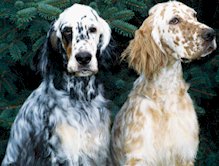

|
All About English |
AKC Standard |
The English Setter's development as a breed is credited to Mr. Edward Laverack who, in 1825, developed a strain of elegant yet efficient gundogs. For fifty years the 'Laverack' setters were the most sought after, but their popularity was eclipsed by the 'Llewellin' strain bred by Mr. Purcell Llewellin. Today, this setter is known as the English Setter and is more likely  to be found as a family pet or in the show ring, though some are still very capable working dogs.
to be found as a family pet or in the show ring, though some are still very capable working dogs.The English Setter is intensely friendly and good natured but very active and best suits homes which can provide it with exercise. It is very responsive to training - a heritage of its working gundog background. Its crowning glory is a silky coat with longer 'feathering' on the ears, breeches and forelegs. Its tail is a smooth continuation of the top line tapering to a fine point, with only sufficient length to reach the hock joint. The tail is carried straight and level with the back and feathering straight and silky, hanging loosely in a fringe. The term 'belton' is used to describe the coloring of the English Setter and means that the body is flecked all over with color. Blue belton is white flecked with black and orange belton, lemon belton, liver belton are other permissible colors . Tricolors (blue or liver beltons) with tan markings are also allowable. Whatever the color, the English Setter is one of dogdom's most glamorous breeds.
|
|
Contact Us Last update November 20, 2014 Please direct inquiries concerning website maintenance to webmaster |